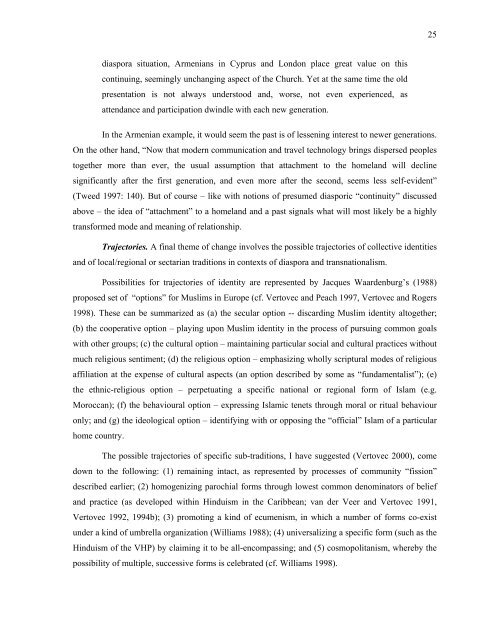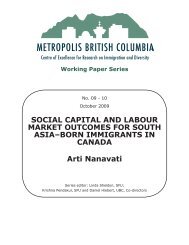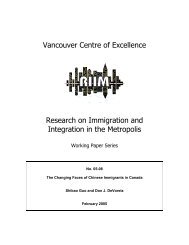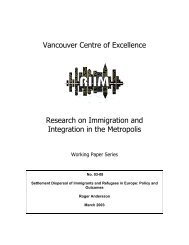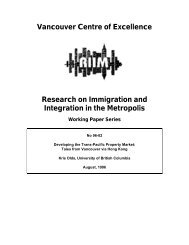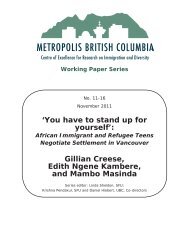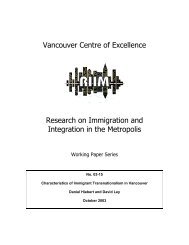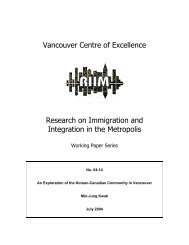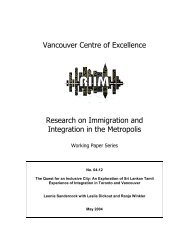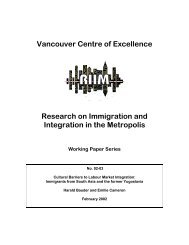Religion in Migration, Diasporas and Transnationalism - Metropolis BC
Religion in Migration, Diasporas and Transnationalism - Metropolis BC
Religion in Migration, Diasporas and Transnationalism - Metropolis BC
Create successful ePaper yourself
Turn your PDF publications into a flip-book with our unique Google optimized e-Paper software.
25<br />
diaspora situation, Armenians <strong>in</strong> Cyprus <strong>and</strong> London place great value on this<br />
cont<strong>in</strong>u<strong>in</strong>g, seem<strong>in</strong>gly unchang<strong>in</strong>g aspect of the Church. Yet at the same time the old<br />
presentation is not always understood <strong>and</strong>, worse, not even experienced, as<br />
attendance <strong>and</strong> participation dw<strong>in</strong>dle with each new generation.<br />
In the Armenian example, it would seem the past is of lessen<strong>in</strong>g <strong>in</strong>terest to newer generations.<br />
On the other h<strong>and</strong>, “Now that modern communication <strong>and</strong> travel technology br<strong>in</strong>gs dispersed peoples<br />
together more than ever, the usual assumption that attachment to the homel<strong>and</strong> will decl<strong>in</strong>e<br />
significantly after the first generation, <strong>and</strong> even more after the second, seems less self-evident”<br />
(Tweed 1997: 140). But of course – like with notions of presumed diasporic “cont<strong>in</strong>uity” discussed<br />
above – the idea of “attachment” to a homel<strong>and</strong> <strong>and</strong> a past signals what will most likely be a highly<br />
transformed mode <strong>and</strong> mean<strong>in</strong>g of relationship.<br />
Trajectories. A f<strong>in</strong>al theme of change <strong>in</strong>volves the possible trajectories of collective identities<br />
<strong>and</strong> of local/regional or sectarian traditions <strong>in</strong> contexts of diaspora <strong>and</strong> transnationalism.<br />
Possibilities for trajectories of identity are represented by Jacques Waardenburg’s (1988)<br />
proposed set of “options” for Muslims <strong>in</strong> Europe (cf. Vertovec <strong>and</strong> Peach 1997, Vertovec <strong>and</strong> Rogers<br />
1998). These can be summarized as (a) the secular option -- discard<strong>in</strong>g Muslim identity altogether;<br />
(b) the cooperative option – play<strong>in</strong>g upon Muslim identity <strong>in</strong> the process of pursu<strong>in</strong>g common goals<br />
with other groups; (c) the cultural option – ma<strong>in</strong>ta<strong>in</strong><strong>in</strong>g particular social <strong>and</strong> cultural practices without<br />
much religious sentiment; (d) the religious option – emphasiz<strong>in</strong>g wholly scriptural modes of religious<br />
affiliation at the expense of cultural aspects (an option described by some as “fundamentalist”); (e)<br />
the ethnic-religious option – perpetuat<strong>in</strong>g a specific national or regional form of Islam (e.g.<br />
Moroccan); (f) the behavioural option – express<strong>in</strong>g Islamic tenets through moral or ritual behaviour<br />
only; <strong>and</strong> (g) the ideological option – identify<strong>in</strong>g with or oppos<strong>in</strong>g the “official” Islam of a particular<br />
home country.<br />
The possible trajectories of specific sub-traditions, I have suggested (Vertovec 2000), come<br />
down to the follow<strong>in</strong>g: (1) rema<strong>in</strong><strong>in</strong>g <strong>in</strong>tact, as represented by processes of community “fission”<br />
described earlier; (2) homogeniz<strong>in</strong>g parochial forms through lowest common denom<strong>in</strong>ators of belief<br />
<strong>and</strong> practice (as developed with<strong>in</strong> H<strong>in</strong>duism <strong>in</strong> the Caribbean; van der Veer <strong>and</strong> Vertovec 1991,<br />
Vertovec 1992, 1994b); (3) promot<strong>in</strong>g a k<strong>in</strong>d of ecumenism, <strong>in</strong> which a number of forms co-exist<br />
under a k<strong>in</strong>d of umbrella organization (Williams 1988); (4) universaliz<strong>in</strong>g a specific form (such as the<br />
H<strong>in</strong>duism of the VHP) by claim<strong>in</strong>g it to be all-encompass<strong>in</strong>g; <strong>and</strong> (5) cosmopolitanism, whereby the<br />
possibility of multiple, successive forms is celebrated (cf. Williams 1998).


